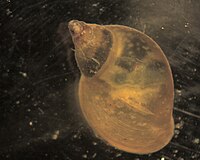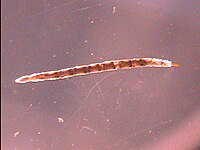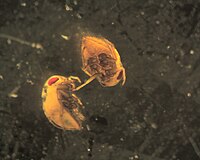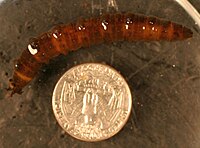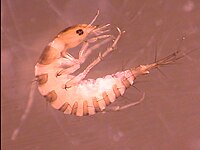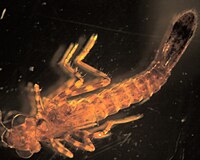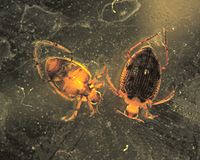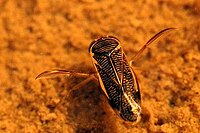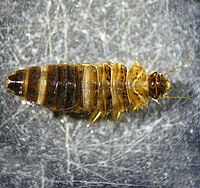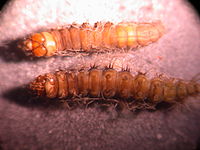Vermont EPSCoR's Streams Project; A Teacher Collaboration on WikiEducator
Openly shared content, practices, and developing resources from Vermont EPSCoR's Streams Project. Join this collaboration and make a difference!
 Stream by boardwalk at Ethan Allen Homestead |
|---|
|
| Basin: | Winooski |
| State or Province: | Vermont |
| Country: | USA |
| Latitude: | 44.507215 |
| Longitude: | -73.230138 |
| School: | Hunt Middle School |
This page is based on samples taken by the hard-working scientists from grades 7 and 8 at Hunt Middle School. All samples were from the stream running through the wetland by the boardwalk at the Ethan Allen Homestead.
....Hunt students: Some are listed in red because we have never collected it with previous schools. Nice job finding some new things. We'll photograph your specimens when time permits and add them to the growing data base.
The students from Hunt found corixids in this stream because the stream drains through a wetland by the bike path.
Lymnaeidae
Members of the family Lymnaeidae belong in the class of Gastropoda. Members contain a single, coiled shell with a right-handed spiral. Differing from those of Planorbidae, members of Lymnaeidae have a larger opening. Respiration in these snails are through lung-like structures. Preferred habitats include those with slow streaming waters and heavy vegetation. These right handed snails are somewhat less tolerant of water pollution than our other common snails.
Images of the family Lymnaeidae and the class Gastropoda.
Pisidiidae
- Order
- Veneroida
- Family
- Pisidiidae
Fingernail clams are the most common small clams that we find in Vermont rivers. Larger bivalves should not be sampled because they may belong to a protected species. Under no circumstances should clams be moved from one river site to another.
Ceratopogonidae
- Order
- Diptera
- Family
- Ceratopogonidae
- Common name
- biting midges
Members of this family look like very straight Chironomidae. They are very long and thin with a distinct head capsule and no prolegs. Some in the lab call them 'bamboo sticks' with eyes.
Image of the distinct head capsule.
Pleidae
- Order
- Hemiptera
- Family
- Pleidae
This family of Hemiptera has a small, convex body and a 'beak' with 3-4 segments.
Click to see the 'beak'.
Tipulidae
- Order
- Diptera
- Family
- Tipulidae
- Common name
- The Crane Fly
- Tied fly
- Gangle Legs
Like other larvae from the order Diptera, members of the family Tipulidae (crane flies) lack legs. Tipulidae have retracted, difficult-to-see head capsules at one end, and a spiracular disk at the other end. The spiracular disk can sometimes look like a face leading to some confusion about which end is which. Upon gently cutting the head open, one can see that the mandibles are not parallel to each other, but rather move against each other.
The genera we've encountered include Antocha, Dicranota, Hexatoma, Limnophila, Molophilus, Pedecia and Tipula.
Dytiscus
- Order
- Coleoptera
- Family
- Dytiscidae
- Genus
- Dytiscus
Adult Dytiscidae have streamlined bodies and hind-legs modified for swimming. They are characterized by the division of the first abdominal segment by the hind coxae. Don't let the paired claws and prominent 'tails' of
Dytiscus larva tempt you to think 'stonefly'; these tails are far less segmented than Plecoptera tails.The head and jaws are also unlike those of stoneflies.
Images of the hind-legs, first abdominal segment, 'tails', Plecoptera tails, and the head and jaws.
Coenagrionidae
- Order
- Odonata
- Family
- Coenagrionidae
- Common name
- narrowwinged damselflies
- Tied fly
- Polly's Green Damsel
These damselfly larvae (sub-order Zygoptera) can be distinguished from dragonfly larvae (sub-order Anisoptera) by their more slender bodies and the presence of three leaf-like gills at the end of the abdomen and The family Coenagrionidae is characterized by its distinctly shaped labium which may or may not be extended.
Images of the gills at the end of abdomen, and another here. An image of the labium, and an extended labium.
Template:Dixidae
- Order
- Diptera
- Family
- Dixidae
Larvae from this occasionally-collected family have oval-shaped lobes attached to their rear end.
Peltodytes
- Order
- Coleoptera
- Family
- Haliplidae
- Genus
- Peltodytes
Both larvae and adults of this family of beetle can be found in ponds. The abdomen of the larvae end in 1-2 long filaments, and long filaments are also found protruding for elsewhere on its body. The adults are characterized by their hind coxae which are greatly expanded and cover the first couple abdominal segments.
Image of the hind coxae.
Template:Corixidae
- Order
- Hemiptera
- Family
- Corixidae
The common name for corixids in the United States is "Water boatman"; this same common name is used for a different insect in the British Isles illustrating the value of formal scientific names. Hardened wings that cross over each other is a trait that these insects share with other hemipterans. Lack of a boat-like keel separates corixids from back swimmers. These insects are common in ponds and sometimes collected in streams that drain pond and wetland habitats.
Scirtidae
- Family
- Scirtidae
- Genus
- Scirtidae
As their common name suggests, marsh beetles are found among vegetation in aquatic habitats. They have a distinctive shape and the photograph should help with identification.
Pyralidae
- Order
- Lepidoptera
- Family
- Pyralidae

